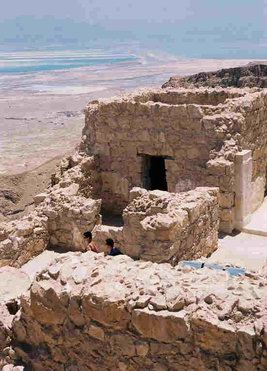 Nearly desperate to ward off(注1)suicide bombers(注2),Israel is thinking about building a security fence to wall out(注3) Palestinians. "It's not very difficult to construct," former Prime Minister Benjamin Netanyahu declared recently. Nearly desperate to ward off(注1)suicide bombers(注2),Israel is thinking about building a security fence to wall out(注3) Palestinians. "It's not very difficult to construct," former Prime Minister Benjamin Netanyahu declared recently.
But it's hard to envision(注4) exactlyswheresit would go. Something elaborate and intricate(注5) enough to protect the myriad(注6) settlements scattered in the West Bank(注7) seems impractical. But the more important questions is whether walls work, and if any lesson can be drawn from history. Walling oneself off from the enemy goes back at least to the Trojans(注8) ?one of the more famous examples of a barricade(注9) that failed to accomplish its mission.
Walls can be circumvented(注10) by changes in technology, population pressures on the other side and the mobility and stealth of the enemy. The Great Wall of China was unsuccessful, according to William McNeill, a professor of the history at the University of Chicago, because it was too long. The nomads(注11) who were China's enemies could move faster on horses than the Chinese infantry, enabling them to mass fighters at any point along the wall before the Chinese could scurry(注12) to repel them. In the end, the Chinese kept their enemies at bay not by blocking them but by reaching accommodations(注13) with them.
The history of walls was accompanied by the invention of various devices to breach(注14) them, from catapults(注15) to multistory contraptions(注16) that could be hauled up to the enemy fortifications. Genghis Khan(注17), the Mongol invader, attacked Chinese walls with projectile(注18)-firing equipment that could be carried on wagons and pack animals.
A dramatic example of walls and technology changing the course of history is recalled in a new book, "The Shield of Achilles," by Philip Bobbitt. He cites the destruction of the walls surrounding Constantinople (now Istanbul)in 1453 as a turning point in the development of the modern state. Built on seven hills overlooking the Bosporus, Constantinople was regarded as impregnable(注19) until the Ottoman Turks battered its walls to rubble with a new invention: huge wrought-iron tubes(注20) that could fire balls made out of stone.
Turkish cannons were unwieldy(注21), but French experts discovered they could make cannon balls with the same process used to forge church bells. At the end of the 15th century, Charles VIII of France invaded the Italian Peninsula with his new cannons.
Perhaps the last great wall theorist was Sebastien Le Prestre de Vauban(注22), chief military engineer under Louis XIV of France. Acknowledging that it was impossible to make a wall that couldn't be breached, he constructed a series of walls featuring zigzags to slow the enemy down in time for reinforcements to arrive. The modern heir to Vauban's fortifications is the Demilitarized Zone(注23) on the Korean Peninsula, an elaborate set of barriers that could probably do little more than temporarily impede(注24) an invasion from the North. What prevents North and South Korea from gettingsintosa war, many experts agree, is not the DMZ but deterrence(注25) ?the willingness of either side to retaliate against the other with full force.
Modern history has not generally looked kindly on walls. One of the most famous walls was the colossally(注26) unsuccessful system of fortifications overseen by the French War Minister Andr? Maginot in the 1930s. It's only achievement was to give the French a false sense of security against the Germans, who easily circumvented the Maginot Line(注27) by sweeping through Belgium. The Berlin Wall succeeded in keeping Germans out of the West, but whatever its security value, it served as a potent(注28) symbol of Soviet power at that time.
Studying these examples, Israelis might conclude that walls can slow down a determined enemy, but never work fully; that walls are not a substitute for political accommodations, and that they can serve as a focus for enemy propaganda far outweighing whatever sense of security they provide. Putting up a wall is not so much a strategy as a symbol for the absence of one.
| ![]() 本网站由北京信息港提供网络支持
本网站由北京信息港提供网络支持
![]() 本网站由北京信息港提供网络支持
本网站由北京信息港提供网络支持